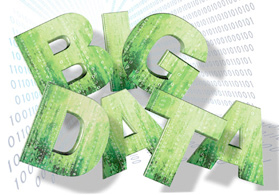
Back in September, I spoke on a panel at Dreamforce in which I used my Nike FuelBand to illustrate the difference between data and metrics, arguing that the difference is meaning: data is the raw material; metrics are one way you can use that material to create meaning. Here’s an example.
While counting calories was popularized in the early 20th century, the concept of a counting steps is relatively new. A couple of years ago, if you asked me how many steps I walked per day, I would have had no idea and, frankly, would have wondered why you cared. Then people started talking about the health benefits of walking 10,000 steps per day, and it became meaningful to a segment of the culture. While it’s not a “magic number,” and I am not confident that my FuelBand tracks my steps with complete accuracy, it’s not a bad barometer either. 5,000 – 6,000 mean I need to get moving; I really feel the difference when I’ve logged 12,000 or more. To some extent, steps walked per day has become a new health metric, at least for me.
Last year, Altimeter Group introduced the three themes we are focused on from a research point of view. The Sentient World is particularly intriguing, as it encompasses the implications of a world in which many devices–not just your phone, but your car, your carpet, your refrigerator, your fitness device or even prosthetic–collect and transmit data streams. And it’s not just devices, but the apps and platforms and APIs that collect and aggregate and analyze and share–that help to create the phenomenon we think of as “Big Data.”
There are many fascinating and worrisome implications to Big Data. On the consumer side, we worry first about privacy, then about being overwhelmed with more data than we can handle. We want accountability, relevance, control, utility, signal-to-noise ratio, ease of use. On the business side, we worry about liability, cost, processes, training, signal-to-noise ratiocost, analysis, integration, ownership and ROI. And cost.
All of us–whether in our business or personal lives–want what so many of my clients call actionability, or that nugget of insight in the data that tells us what to do next. Or, to put it another way, we are becoming increasingly overwhelmed by raw material, and increasingly in need of meaning.
The default way to solve this challenge is to give the user more stuff: more reports, more dashboards, more alerts, more badges, more notifications, more sizes and color choices.
But what I want, and what I hear from nearly everyone I speak to, is more meaning. More insight. More understanding of risks, opportunities, context. More guidance on what to do next.
The intentions are good, but the experience is broken.
Maybe we are at a point, as the Internet was several years ago, where we need to create a discipline around the experience and meaning of data.
Unlike information design or user experience design (of which I am a huge fan; don’t get me wrong), data experience design would encompass the experience of using many types of data across channels, platforms and in real life. In that sense, it wouldn’t be a replay of UX, but a multi-dimensional discipline that articulates the rights of users, the criteria for “good” data–the methodologies, confidence levels, presentation, usability, privacy guardrails, governance, transparency, implications–everything we need to think about to make meaning from the gathering yottabytes and whateverbytes that continue to descend algorithmically upon us.
Whatever it looks like, whatever form it ultimately takes, one thing is clear: we need to jump off the hamster wheel for a moment and start to think systematically about the impact of big data and data science so we don’t end up creating a larger, more intricate and expensive replica of the past.
Whatever it looks like, whatever form it ultimately takes, one thing is clear: we need to jump off the hamster wheel for a moment and start to think systematically about the impact of big data and data science so we don’t end up creating a larger, more intricate and expensive replica of the past.
 Susan Etlinger is an industry analyst at Altimeter Group, where she works with global companies to develop both social media listening and measurement strategies that support their business objectives. Susan has a diverse background in marketing and strategic planning within both corporations and agencies. She’s a frequent speaker on social media and analytics and has been extensively quoted in outlets including Fast Company, BBC, New York Times and The Wall Street Journal. Find her on Twitter at @setlinger and at her blog, Thought Experiments, at susanetlinger.com.
Susan Etlinger is an industry analyst at Altimeter Group, where she works with global companies to develop both social media listening and measurement strategies that support their business objectives. Susan has a diverse background in marketing and strategic planning within both corporations and agencies. She’s a frequent speaker on social media and analytics and has been extensively quoted in outlets including Fast Company, BBC, New York Times and The Wall Street Journal. Find her on Twitter at @setlinger and at her blog, Thought Experiments, at susanetlinger.com.
Originally published susanetlinger.wordpress.